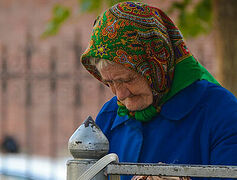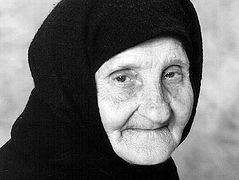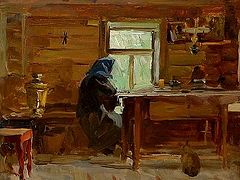 The winter of 2020—2021. Once noisy and lively, Tbilisi doesn’t look like itself. The Georgian capital is paralyzed: public transport is at a standstill, many stores are closed, and pedestrians in masks try their best to observe social distancing.
The winter of 2020—2021. Once noisy and lively, Tbilisi doesn’t look like itself. The Georgian capital is paralyzed: public transport is at a standstill, many stores are closed, and pedestrians in masks try their best to observe social distancing.
But the flow of people to a modest grave at the old Kukia Cemetery on the outskirts of the city does not stop. They travel there on foot, by taxi or on their own vehicles.
Here is a tired woman who has come with two small children—she is praying fervently for something, while the little ones are playing nearby. Here is a young pair; it looks like they have come for the first time. Looking at each other bashfully, they kneel down and ask for something for a long time. Three young ladies have arrived. Their minds are clearly occupied with matters of the heart, and they too hope to receive help. Almost everyone leaves red apples on the black marble tombstone. There is the following inscription on the gravestone:
“Anastasia Nikisheva. 1886—1970.”
More and more people in Georgia are learning about Anastasia the “Seated”, as she is popularly called, and flock to her grave.
The beginning of this story is reminiscent of a fairy tale about an evil stepmother. At the dawn of the last century a Russian girl lived in Tbilisi. In the nineteenth century her father, an engineer, had relocated from St. Petersburg to Georgia to build a railroad there. At that time, those who worked at the locomotive depot were given land in the neighborhood of Nakhalovka in Tbilisi. He built a house not far from the Church of the Nativity of the Theotokos and remained there. Widowed at a young age, he remarried despite the fact that his dying wife had asked him not to do so, as she did not want her daughter to have a stepmother. His daughter Anastasia was very religious and beautiful, and she sang in the church choir. Once at a ball at the Vorontsov Palace in Tbilisi, the girl met a young officer [according to her official biography, by that time Anastasia’s father was dead and she lived with her stepmother Anfisa and her two younger sisters.—Trans.] The officer fell in love with Anastasia and proposed to her. The stepmother was jealous of her stepdaughter, who would become a noblewoman, and decided to deliberately slander her. When the young officer came to them, she said that the girl had gone mad, that she had just been taken to hospital and there was no hope of recovery.
The would-be fiancé could not bear the sad news and shot himself on the spot. Seeing what had happened, Anastasia sat on a low bench in the middle of the yard and almost never rose to her feet again [according to another and more popular version, she immediately squatted down just outside her house, and remained in that position, almost motionless, till the end of her days. She prayed silently, took only tiny bit of food that was brought to her once a day, and slept little, with her head lowered.—Trans.]. In any weather, she sat in the open, praying that the Lord would forgive her beloved one his grave sin and have mercy on him.
The stepmother could not calm down even after that. She would pour ice-cold water over the girl in winter and try to make Anastasia rise. But the girl stubbornly continued to sit in the middle of the yard, praying day and night. She sat like this all the time—both in the summer heat and the winter cold, covering herself only with a shawl she had knit herself.
The blessed woman sat like this for sixty-five years. The wicked stepmother, for whose soul, no doubt, the girl also prayed, was no longer alive. The Revolution was over, the Civil War ended, the years of Stalinist terror swept through the country like a black cloud, and the Second World War broke out… But Anastasia was still sitting and praying. It seemed that time had no power over her. Over time, her legs grew together below her knees. But, amazingly, despite many years of sitting neither ulcers nor wounds appeared. Many sufferers would come to Anastasia with prayer requests, many would bring food, red apples, but she did not accept gifts from everyone. The police would disperse the visitors, but they continued to gather in the yard despite threats from the authorities. During the Second World War, women who wanted to know what had become of their relatives at the front and whether they were alive would come to Anastasia. Anastasia prayed, and when she gave somebody some earth it meant that the person in question was dead; but when she gave some fruit it meant that he was alive. She predicted, and her predictions always came true.
The ascetic had extraordinary eyes, as Archimandrite Raphael (Karelin) wrote:1
“Her gaze seemed to penetrate a person through and through, and the person involuntarily felt some kind of amazement that was akin to fear, realizing that this gaze saw everything in his soul—his life, past and future.”
Towards the end of her life the ascetic intensified her podvig. She sat down on shards of broken bottles.2 The shards stuck into her body, but there was absolutely no suppuration— which should have occurred according to the laws of nature.
Anastasia reposed in the Lord on June 7, 1970. She was buried in a specially prepared square coffin, since her legs had grown together. She was interred at the Kukia Cemetery.3
I learned about Anastasia the “Seated” from a friend. She met a woman on the internet who, upon learning that she (my friend) lived in Tbilisi, sent her money and asked her to buy and bring flowers to Anastasia’s grave. At that time, my friend started to have very serious issues at her work, and she and her husband went to the cemetery to look for Anastasia’s grave and ask for her help. They found the grave quickly, since there is a sign on the cemetery wall. They asked for the ascetic’s help and laid the flowers there. Anastasia helped my friend, saving her from trouble and slander. Her problems at work were swiftly resolved. My friend gave me a book on Anastasia.4
We were in hard times then. I was supposed to have an expensive operation that was not covered by medical insurance. There was still hope for the help of the mayor’s office and the ministry. I travelled to Anastasia’s tomb and implored her to intercede for me. It was a fine sunny day. I prayed a lot at her grave, asking for a successful outcome of the operation and for financial help. There was an amazing feeling of the living presence of the saint, as if she were right there, next to me, praying to the Lord for me. It was a miracle. The next day I received a text message notifying me that the mayor’s office had transferred a large amount to me, and next the ministry added the same amount. The operation went well, and I went to the grave again—this time to thank Anastasia.
Another miracle of Anastasia we experienced was that a seller refunded us the price of a defective anti-bedsore mattress for my bedridden mother, though he had initially refused to give the money back. My son and I stood up to pray, and barely had we said, “Amen!” when the bell rang and we finally got a refund.
Anastasia helped me in another matter. Due to my mother’s illness, for two years I could not visit the graves of our relatives. Summer passed, fall set in, and I still could not find time to go there. When I came to Anastasia’s grave with my friends, it turned out that our relatives’ graves were a five-minute walk from it! Although we had travelled there for so many years, we did not know what a marvelous person was buried nearby!
The podvig of Anastasia the “Seated” is that of a stylite (pillar asceticism)—even more. It bears resemblance to the podvig of such Russian saints as Blessed Matrona of Moscow and Xenia of St. Petersburg. Like them, Anastasia performed a great bodily podvig; like them, she acquired the sublime gifts of the Spirit; like them, she helped the suffering who came to her day and night; like them, she did not care about herself in the least, voluntarily giving up all earthly blessings.
I believe that the canonization of Anastasia the “Seated” is not far off, and that this wonderful ascetic of God will one day be venerated nationwide!




